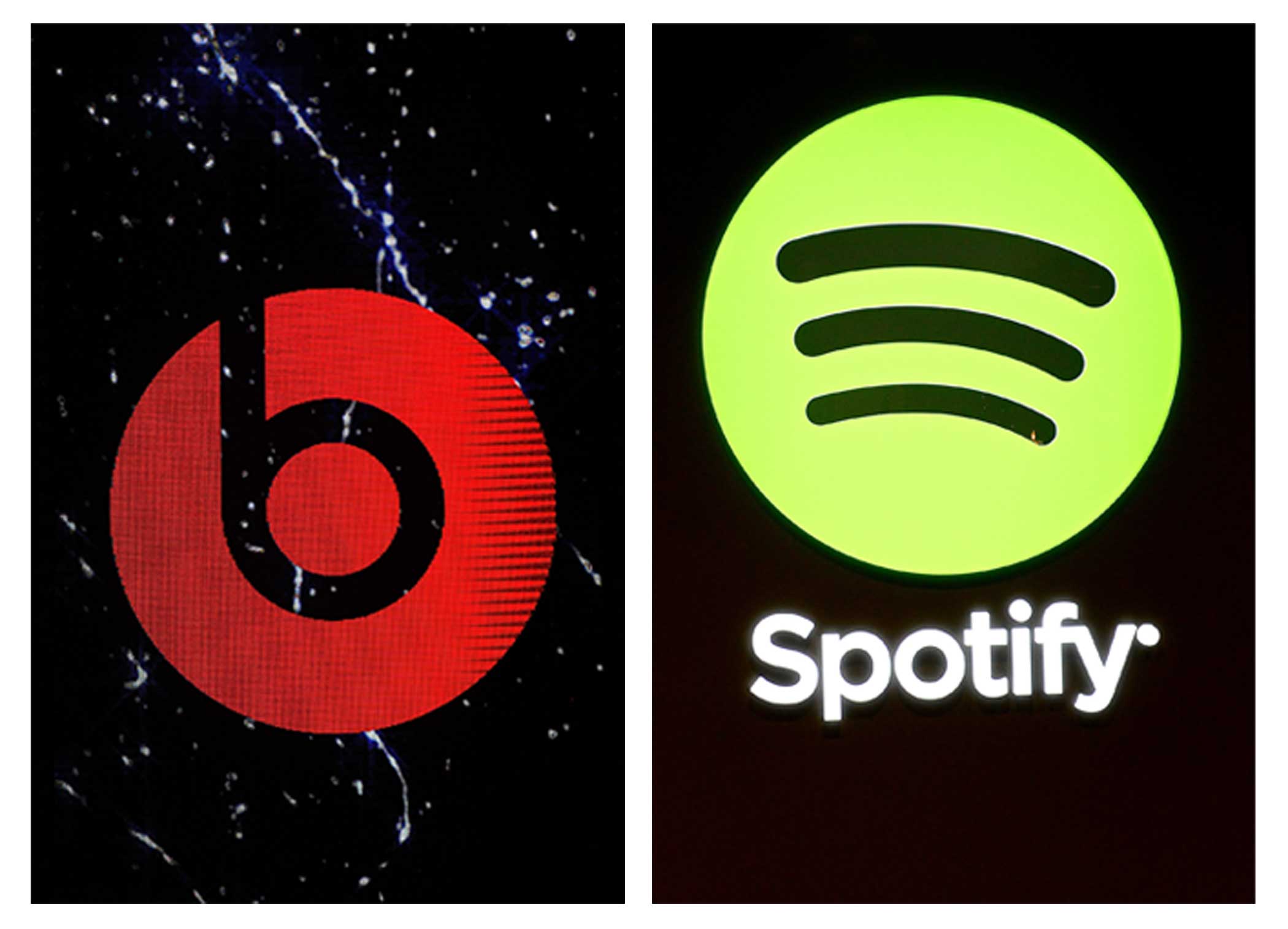
It’s been almost nine months since Apple’s $3 billion purchase of Beats catapulted the Dr. Dre-backed streaming music service into the limelight for casual music listeners. And while Apple is reportedly working on an overhaul of the service, I spent the last nine months as a paid Beats Music subscriber, after having used Spotify exclusively for more than a year.
Beyond the music, the differences between the two services are stark. Here is what you need to know in comparing the two most prominent (with apologies to all the other players) streaming music services on the market:
Musical Selection
This is a largely subjective category, because it really depends on what you’re looking for. For instance, some tracks, such as “Jungle” by Jay-Z, appear exclusively on Beats before rolling into other services, while other artists, like Led Zeppelin, appeared on Spotify first, then elsewhere next.
Whether these exclusives will affect you is a matter of what kind of music you prefer, but it’s hard to know in advance of subscribing which artists will strike what deals with which service. And the end, most albums end up being available everywhere. Except for Taylor Swift — she pulled her latest tracks from every subscription streaming service.
Winner: Tie
User Interface
One of the biggest differences between these two services (specifically their apps) is the way users interact with them. Spotify has a menu-driven interface that requires a lot of taps to dive into an artist’s catalog from the main screen. Meanwhile, Beats has a visual-driven interface with large tiles that spring users right into the content they want to listen to.
Once a track is playing, Beats transforms into a full-screen player, with large buttons and progress meters, making it ideal for skipping songs on the fly, like when you’re driving (tsk, tsk). Spotify, meanwhile, shrinks the track down to a mini-player that takes up the smallest ribbon at the bottom of the screen. Tapping on the song’s tiny album art will expand it to a full-sized player, but that’s hardly intuitive — and pretty inconvenient, considering the image’s size.
Winner: Beats
Free Accounts
Spotify will let you listen via its mobile app without paying for an account, but that only provides you with a shuffle mode. If you want to listen to an exact song, you’ll have to upgrade to the premium service. Spotify also says “on tablet and computer, you can play any song, any time,” but I found this to be untrue. In fact, this frustration led me to resubscribe to the service. (Tricky move, Spotify.)
Meanwhile, technically, Beats Music does not have a free version. But Apple does offer iTunes Radio gratis, though it doesn’t come close to the free version of Spotify.
Winner: Spotify
PHOTOS: See Taylor Swift Over the Years


































Social Integration
Both Beats Music and Spotify offer social integration, letting you post your favorite songs on Twitter and Facebook for your friends to enjoy. But Spotify, which has historically used Facebook Connect to power login information for its service, gives music fans a much richer social experience by allowing you to see your friends’ listening activity.
At first, when Facebook was allowing Spotify to publish activity to the sites News Feed, Spotify seemed hyperactive, alerting every friend to every song that was played. But through some toning down and refinement, Spotify’s social feed is much calmer — you really only see it on a sidebar on the Spotify desktop app unless you dive into the “activity” menu on the service’s mobile app.
Beats, meanwhile, doesn’t show friends’ activity, which could be a selling point if you’re embarrassed by your musical taste, or don’t care to know what your friends are listening to. But it’s hard not to look at Beats’ lack of social integration and see Apple’s failures in this space. The company’s Ping social networking feature in iTunes was one of the company’s most high-visibility failures, and even Game Center, which many iPhone users have logged into (but relatively few use) isn’t very popular.
Winner: Spotify
Desktop App
Don’t spend too long looking for a desktop version of the Beats app — it doesn’t exist, not even on the Mac App Store. Instead, the service is meant to run through your web browser, though good luck with that. Personally, as hard as I push my browser (I have 14 tabs open right now, and that’s below average for me), I’d rather have a separate application chewing on the RAM-intensive music streams. And comically, early on, I couldn’t get Safari to play audio from the Beats service at all — I had to switch to Google Chrome. But that brings up an interesting point: If you really do want a Beats Music app, you can find one on the Chrome Web Store.
Spotify, meanwhile, might be the best desktop music app I’ve ever used. More than just a music player, it’s actually a platform for the service, which allows other programmers to make software that interacts with Spotify. For example, you can link your Spotify account to Last.fm to generate personalized music choices, or you can view lyrics to the song you’re listening to through MusiXmatch.
Spotify’s willingness to open itself up to these outside developers is a key difference between it and Beats Music, and (other than its great library) might be its best feature.
Winner: Spotify
Killer Feature
While most people like Spotify mostly for its music and social features, its platform-like interactivity with other services (described above) is truly its killer feature, letting the service expand and morph in new ways. For instance, if used with certain apps, Spotify’s desktop app can become a karaoke screen, or with other apps it can compete with music-suggesting services like Pandora.
Meanwhile, what made Beats unique was a pair of features. Firstly, expertly-crafted playlists created by humans, not computers, instantly gave users a trove of mixes to choose from. But this feature was quickly aped by Spotify through its ability to let people share their playlists and via expert-driven apps like Rolling Stone Recommends.
Beats’ other killer feature was a fun way to make your own mix called “The Sentence,” where users could tell the app what they are doing (“working out,” “cooking,” hanging out,” etc.) with whom (“my friends,” “my bff,” etc.) and to what kind of music they wanted to hear (“hip-hop,” “bluegrass,” “metal,” etc.). At first, it seems like a great idea, but once you realize you want to chill, party, nap, and barbecue to 90’s rock, it becomes clear that you really don’t need a suggestion engine that caters to every musical genre. The gimmick gets old, quick.
Winner: Spotify
Overall Winner
While Beats user interface is far and away more friendly, over the past nine months with the service I found myself discovering fewer new artists and listing to less music than when I used Spotify. I wanted Beats to be better than it really is, so much so that I probably kept my subscription longer than I otherwise would have. But one week back with Spotify, and I’m back in the fold with all my old playlists — which, ironically, I exported from iTunes.
Maybe Apple’s next iteration of Beats, whether it’s under that name or folded back into iTunes, will be better. But it would take a massive shift in attitude from Apple, because they’d need to embrace social networks that they don’t own and third party developers in a way they currently don’t.
Winner: Spotify
More Must-Reads from TIME
- Cybersecurity Experts Are Sounding the Alarm on DOGE
- Meet the 2025 Women of the Year
- The Harsh Truth About Disability Inclusion
- Why Do More Young Adults Have Cancer?
- Colman Domingo Leads With Radical Love
- How to Get Better at Doing Things Alone
- Michelle Zauner Stares Down the Darkness
Contact us at letters@time.com